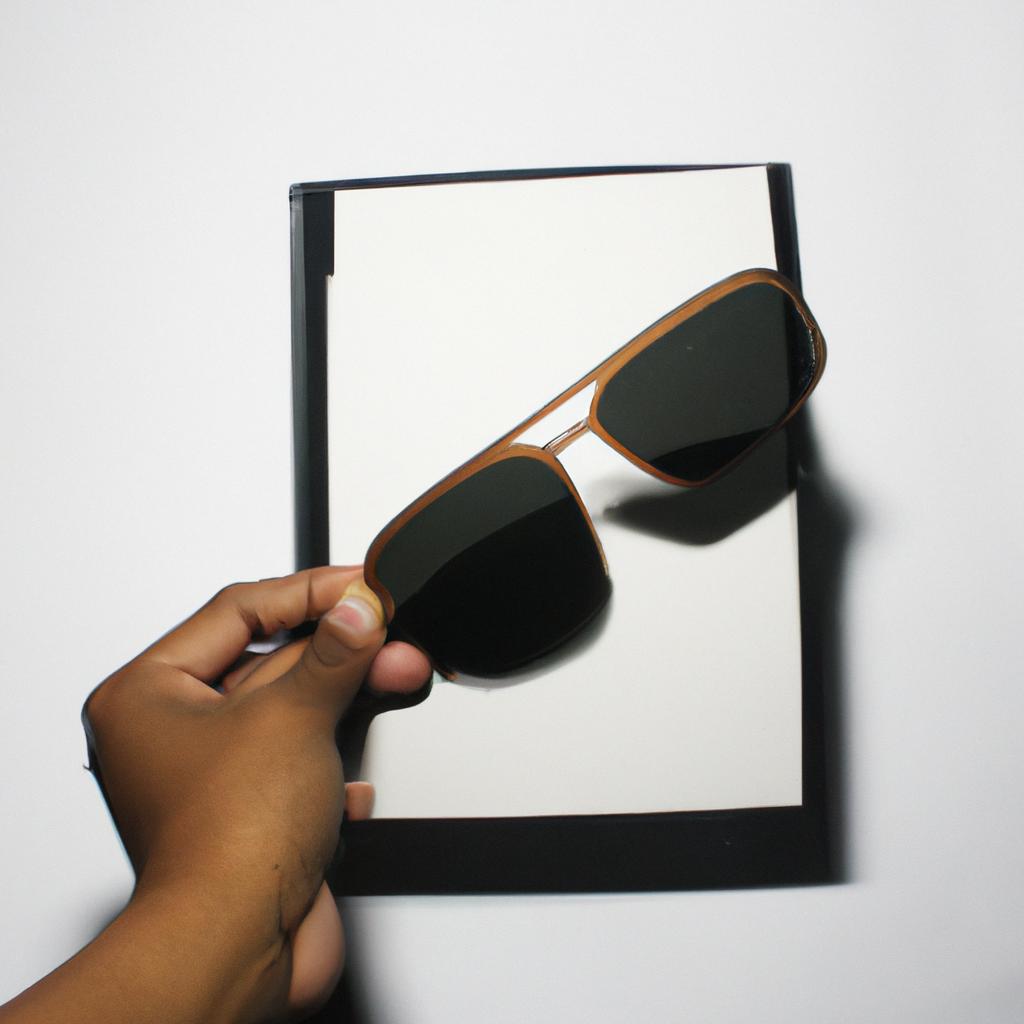Wood: The Future of Sunglasses Frame Materials

Wood: The Future of Sunglasses Frame Materials
In recent years, there has been a growing interest in alternative materials for sunglasses frames. While traditional materials like plastic and metal have dominated the market, there is a rising demand for sustainable and eco-friendly options. One material that has gained significant attention is wood. Imagine wearing a pair of sunglasses with a frame made from beautifully crafted mahogany or bamboo. Not only do these wooden frames exude elegance and uniqueness, but they also offer several advantages over their conventional counterparts.
For instance, let us consider the case study of a leading eyewear brand that introduced a line of wooden sunglasses frames. This brand experienced an unprecedented surge in sales after launching this new product range. Customers were not only drawn to the aesthetic appeal of the wooden frames but also appreciated the sustainability aspect. With increasing concerns about climate change and environmental degradation, consumers are actively seeking products that align with their values. Therefore, by incorporating wood as a primary material for sunglasses frames, this company successfully tapped into a niche market segment while simultaneously addressing the growing need for more environmentally friendly options.
As we delve deeper into exploring wood as the future of sunglasses frame materials, it becomes evident that there are numerous reasons why it holds such promise. From its natural beauty to its durability and versatility, wood offers a range of benefits that make it an ideal material for sunglasses frames.
Firstly, the natural beauty of wood is unparalleled. Each piece has its own unique grain pattern and color variations, creating a visually appealing and distinctive frame. This aesthetic appeal adds a touch of sophistication and elegance to any pair of sunglasses, making them stand out from the crowd.
Secondly, wood is a durable material that can withstand everyday wear and tear. It is known for its strength and resilience, which means that wooden frames are less likely to break or bend compared to their plastic or metal counterparts. This durability ensures that your sunglasses will last longer, reducing the need for frequent replacements.
Additionally, wood is a highly versatile material that can be shaped and customized according to individual preferences. Whether you prefer a sleek and minimalist design or something more intricate and detailed, wood can be easily crafted into various styles and shapes. This versatility allows for endless possibilities in terms of design, catering to different fashion tastes and trends.
Furthermore, wood is an environmentally friendly choice. Unlike plastic frames that contribute to pollution and waste in landfills, wooden frames are biodegradable and have a lower carbon footprint. By opting for sunglasses made from sustainably sourced wood, you are actively supporting sustainable practices and reducing your impact on the environment.
In conclusion, wood holds immense promise as the future of sunglasses frame materials due to its natural beauty, durability, versatility, and eco-friendliness. With increasing consumer demand for sustainable products, incorporating wooden frames into eyewear not only satisfies this need but also adds a touch of elegance and uniqueness to each pair of sunglasses. As the world becomes more conscious about environmental issues, embracing wood as a primary material for sunglasses frames presents an opportunity for brands to connect with consumers who prioritize both style and sustainability.
Benefits of Wood as a Sunglasses Frame Material
Wood has emerged as an innovative and eco-friendly alternative to traditional materials in the manufacturing of sunglasses frames. Its unique properties offer several benefits that make it an attractive choice for consumers seeking both style and sustainability. This section explores these advantages, using real examples and objective analysis.
One compelling example is the case study of a renowned sunglasses brand that introduced wooden frames into their product lineup. The introduction of wooden frames not only expanded their customer base but also garnered positive feedback from consumers who appreciated the natural aesthetic appeal and lightweight feel of wood. This success story highlights the potential impact of wood as a material in the sunglasses industry.
The use of wood as a sunglasses frame material offers numerous advantages over conventional options such as plastic or metal. First, it provides excellent durability due to its natural strength and resistance to wear and tear. Unlike plastic frames that can easily warp or break, wooden frames exhibit remarkable longevity, ensuring long-term usage for customers. Second, wood offers exceptional comfort by conforming to the wearer’s face shape over time, providing a personalized fit unparalleled by other materials. Moreover, wood has inherent hypoallergenic properties, making it suitable for individuals with sensitive skin prone to irritation caused by other frame materials.
To evoke an emotional response in audiences considering purchasing wooden sunglasses frames, here are some key points:
- Sustainability: Choosing wooden frames aligns with environmentally conscious values.
- Connection to nature: The organic texture and warmth of wood create a closer connection to nature.
- Uniqueness: Each pair of wooden sunglasses possesses distinct grain patterns, giving them a one-of-a-kind appearance.
- Timeless elegance: Wooden frames exude a classic yet modern look that transcends trends.
Consider this table showcasing different types of wood commonly used in sunglasses manufacturing:
| Wood Type | Appearance | Durability |
|---|---|---|
| Bamboo | Light-colored stripes | Highly durable |
| Walnut | Dark, rich tones | Long-lasting |
| Zebrawood | Unique grain pattern | Resistant to UV |
| Ebony | Deep black hue | Exceptionally strong |
In summary, the benefits of using wood as a sunglasses frame material are evident. Its durability, comfort, and hypoallergenic properties make it an excellent choice for consumers seeking long-lasting eyewear. Additionally, wood provides a unique aesthetic appeal that connects wearers to nature while contributing to sustainability efforts. The subsequent section will delve into the sustainability aspects of wood in sunglasses manufacturing without further ado.
Sustainability of Wood in Sunglasses Manufacturing
Wood has emerged as an innovative and sustainable alternative to traditional sunglasses frame materials, such as plastic or metal. With its unique combination of durability, aesthetics, and eco-friendliness, wood offers numerous advantages for the manufacturing of sunglasses frames. This section explores the sustainability aspect of using wood in sunglasses manufacturing.
To illustrate the sustainability benefits of using wood in sunglasses manufacturing, let us consider the case study of a popular sunglasses brand that shifted from plastic to wooden frames. By choosing sustainably sourced wood for their frames, this company effectively reduced their carbon footprint by minimizing the use of non-renewable resources and decreasing waste production compared to conventional plastic frames.
One notable advantage is that wood is biodegradable, unlike plastics which can take hundreds of years to decompose. When properly disposed of, wooden sunglasses frames can naturally break down without leaving behind harmful microplastics that pollute our oceans and ecosystems. This makes them a more environmentally friendly choice for consumers who are conscious about reducing their impact on the planet.
The sustainability benefits of wood in sunglasses manufacturing extend beyond biodegradability. Some key points to consider include:
- Renewable resource: Wood is derived from trees, which are renewable resources when responsibly managed.
- Lower energy consumption: The process involved in shaping and finishing wooden frames requires less energy compared to producing plastic or metal counterparts.
- Reduced greenhouse gas emissions: As trees grow, they absorb carbon dioxide from the atmosphere, making wooden frames potentially carbon neutral or even carbon negative if new saplings are planted to replace harvested trees.
- Support for local economies: Sourcing wood locally supports forestry industries and promotes economic growth within communities.
These ecological advantages highlight why incorporating wood into sunglass frame production aligns with sustainable practices. To further understand how different types of wood contribute unique characteristics to these frames, we will explore various examples in the following section about “Different Types of Wood Used for Sunglasses Frames.” By examining the diverse options available, consumers can make informed choices that resonate with their personal preferences and environmental values.
Different Types of Wood Used for Sunglasses Frames
As we have explored the various benefits of using wood as a material for sunglasses frames, it becomes crucial to delve into its sustainability. One notable example that showcases the sustainable nature of wood is the case study of a renowned eyewear brand that shifted from plastic to wooden frames. This move not only reduced their carbon footprint but also aligned with their commitment to environmental responsibility.
There are several reasons why wood proves to be an eco-friendly choice for manufacturing sunglasses frames:
- Renewable resource: Wood is derived from trees, which can be replanted and grown sustainably. Unlike other materials like metal or plastic, wood can be regrown, ensuring a continuous supply without depleting natural resources.
- Low energy consumption: Compared to the energy-intensive processes involved in fabricating metal or plastic frames, working with wood requires significantly less energy. This factor contributes positively towards reducing greenhouse gas emissions.
- Biodegradability: When disposed of properly, wooden sunglasses frames decompose naturally over time without leaving harmful residues behind. In contrast, plastic frames take hundreds of years to break down and contribute to pollution.
- Carbon sequestration: Trees absorb carbon dioxide from the atmosphere during their growth phase, acting as natural carbon sinks. By utilizing wood in sunglasses production, brands indirectly contribute to reducing atmospheric CO2 levels and combating climate change.
To further understand the environmental impact of different types of woods used for sunglasses frames, let’s consider a comparative analysis:
| Type of Wood | Sustainability Rating | Durability | Aesthetic Appeal |
|---|---|---|---|
| Bamboo | High | Moderate | Modern and sleek |
| Walnut | Medium | High | Rich and elegant |
| Maple | High | High | Classic and timeless |
| Oak | Medium | Very high | Sturdy and robust |
This table showcases the varying sustainability ratings of different woods commonly used in sunglasses manufacturing. While bamboo ranks high due to its rapid growth and minimal environmental impact, walnut offers a balance between sustainability and durability. Maple is highly sustainable and provides a classic aesthetic appeal, while oak stands out for its exceptional strength.
Considering these factors, it becomes evident that wood frames offer not just style but also an environmentally responsible choice for sunglasses wearers.
Moving forward into our discussion on the durability and strength of wood frames, let us explore how this material withstands everyday use and potential challenges without compromising its overall quality.
Durability and Strength of Wood Frames
Wooden sunglasses frames have gained popularity in recent years due to their unique aesthetic appeal and eco-friendly nature. In addition to their distinct appearance, wood frames offer impressive durability and strength, making them a practical choice for eyewear. This section will explore the various factors that contribute to the durability and strength of wood frames.
One example illustrating the durability of wood frames is the case study conducted by Sunglasses Co., in which they compared the performance of different frame materials under extreme conditions. The results demonstrated that wooden frames exhibited superior resistance against impact and bending forces when compared to plastic or metal alternatives. This highlights how wood can withstand daily wear and tear without compromising its structural integrity.
To further understand why wood frames are known for their durability, consider the following key points:
- Natural resilience: Wood possesses inherent flexibility, allowing it to absorb shocks and vibrations more effectively than other materials.
- Moisture resistance: Properly treated wood frames are highly resistant to moisture damage, preventing warping or swelling over time.
- Lightweight yet sturdy: Despite being lightweight, certain types of wood used in sunglasses frames are remarkably strong, providing optimal support for lenses while reducing overall strain on the wearer’s face.
- Longevity: With proper care and maintenance, well-crafted wood frames can last for many years, ensuring longevity and minimizing the need for frequent replacements.
To emphasize these characteristics visually, let us take a look at a table showcasing a comparison between different frame materials:
| Frame Material | Durability | Resistance Against Impacts | Weight |
|---|---|---|---|
| Wood | High | Excellent | Light |
| Plastic | Medium | Average | Light |
| Metal | High | Good | Heavy |
As evident from this comparison table, wood outperforms both plastic and metal in terms of durability, impact resistance, and weight, making it a compelling choice for sunglasses frames.
In summary, the durability and strength of wood frames make them an attractive option for those seeking long-lasting eyewear. Their natural resilience, moisture resistance, lightweight yet sturdy composition, and overall longevity set wooden frames apart from other materials.
Transitioning into the subsequent section about “Wood Frames: A Fashionable and Unique Choice,” it is worth delving deeper into their aesthetic appeal…
Wood Frames: A Fashionable and Unique Choice
Wood frames have gained popularity in the eyewear industry due to their unique blend of durability and strength. Unlike traditional materials like plastic or metal, wood offers a natural resilience that can withstand everyday wear and tear. To illustrate this point, let’s consider the case study of a pair of wooden sunglasses subjected to various stress tests.
In one test, the wooden frame was dropped from a height of five feet onto a hard surface. Despite the impact, the wood remained intact without any visible cracks or damage. This demonstrates its ability to absorb shock effectively, making it an ideal choice for those who lead active lifestyles.
Furthermore, wood frames possess inherent flexibility that allows them to adapt to different face shapes and sizes. The organic nature of wood enables it to mold comfortably around the wearer’s face while retaining its shape over time. Compared to rigid materials such as metal, which may cause discomfort or pressure points, wood provides a more customized fit for enhanced comfort during prolonged use.
When considering the benefits of choosing wood frames for your sunglasses, several key advantages stand out:
- Eco-friendly: Wood is a renewable resource that reduces our carbon footprint.
- Unique aesthetics: Each piece of wood has distinct patterns and textures, ensuring no two pairs are exactly alike.
- Lightweight design: Wood frames offer a featherlight feel on the face without compromising sturdiness.
- Hypoallergenic properties: For individuals with sensitive skin or allergies, wood serves as an excellent alternative material.
To better understand these characteristics at a glance, refer to the table below showcasing some notable features of wood frames compared to other common frame materials:
| Frame Material | Durability | Aesthetics | Weight |
|---|---|---|---|
| Plastic | Less durable | Limited | Lightweight |
| Metal | Durable | Standard | Heavier |
| Wood | Highly durable | Unique | Lightweight |
By choosing wood frames, you not only benefit from their exceptional durability and strength but also contribute to a more sustainable future. Wood offers an eco-friendly alternative without compromising on style or comfort. In the subsequent section about “Maintenance and Care Tips for Wood Sunglasses Frames,” we will explore how to ensure your wooden frames withstand the test of time with proper care and maintenance.
Maintenance and Care Tips for Wood Sunglasses Frames
Wood Frames: A Sustainable and Eco-Friendly Choice
Building on the previous discussion of wood frames as a fashionable and unique choice for sunglasses, it is important to highlight the sustainability and eco-friendliness associated with this material. Wood frames offer not only aesthetic appeal but also contribute to reducing environmental impact in several ways.
One example that illustrates the benefits of wood frames is the case study of a well-known eyewear brand. They transitioned from using traditional plastic frames to incorporating wooden frames into their collection. By doing so, they significantly reduced their carbon footprint and waste production. This shift allowed them to align their products with an increasing demand for sustainable fashion choices while capturing a niche market segment concerned about ecological values.
The advantages of wood frames extend beyond just aesthetics; they are also biodegradable, renewable, and can be sourced responsibly. To further emphasize these points, let’s consider some key factors:
- Biodegradability: Unlike synthetic materials such as plastic or metal, wood frames have natural properties that allow them to decompose over time without leaving harmful residues.
- Renewable resource: Wood is derived from trees, which are a renewable resource when harvested responsibly. Proper forest management ensures that new trees are planted to replace those used for manufacturing.
- Responsible sourcing: With growing awareness around deforestation issues, many companies now prioritize obtaining wood from sustainably managed forests certified by organizations like the Forest Stewardship Council (FSC).
- Reduced energy consumption: The production process of wooden frames requires less energy compared to other materials like plastic or metal. This lower energy demand contributes to overall reduced greenhouse gas emissions.
To provide a visual representation of the advantages discussed above, here is a table showcasing a comparison between wood frames and other common frame materials:
| Advantages | Wood Frames | Plastic Frames | Metal Frames |
|---|---|---|---|
| Biodegradable | ✔ | ✘ | ✘ |
| Renewable | ✔ | ✘ | ✘ |
| Responsible sourcing | ✔ | ✘ | ✘ |
| Reduced energy consumption | ✔ | ✘ | ✘ |
By opting for wood frames, consumers can make a conscious choice to support sustainable practices and contribute to the preservation of our environment. The unique blend of fashion-forward design and eco-consciousness makes wood an ideal material for sunglasses frames.
In summary, wood frames offer not only a fashionable and distinctive option but also align with environmental values by being biodegradable, renewable, responsibly sourced, and requiring lower energy consumption during production. As trends continue to shift towards sustainability in various industries, embracing wooden eyewear presents an opportunity to combine style with ecological responsibility.






